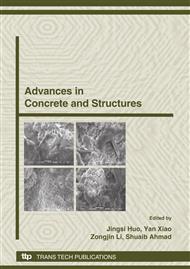p.43
p.55
p.69
p.81
p.89
p.101
p.107
p.115
p.121
Sulfate Crystallization Attack on Cement-Based Materials
Abstract:
The physical crystallization action of sulfate in cement based material, which often occurs by dry-wet cycle, capillary rising and evaporating action, can damage seriously cement-based materials as compared to chemical corrosion by sulfate. The deterioration mechanism of cement-based materials by sulfate crystallization attack, experimental investigations of the process of sodium sulfate crystallization and the factors affecting the process, and the invading track of salt solution by capillary effect are presented in this paper. Results show that the crystal type and crystallization velocity of sodium sulfate is influenced greatly by relative humidity and ambient temperature. There is a close relationship between invading depth and the porosity of concrete. Addition of mineral admixture to concrete can significantly reduce the invading depth of sodium sulfate solution and thereby enhance the resistance of concrete to sulfate crystallization attack.The profile of invading track of salt solution by capillary effect is similar to the shape of concave parabola.
Info:
Periodical:
Pages:
89-99
Citation:
Online since:
October 2008
Authors:
Price:
Сopyright:
© 2009 Trans Tech Publications Ltd. All Rights Reserved
Share:
Citation:


